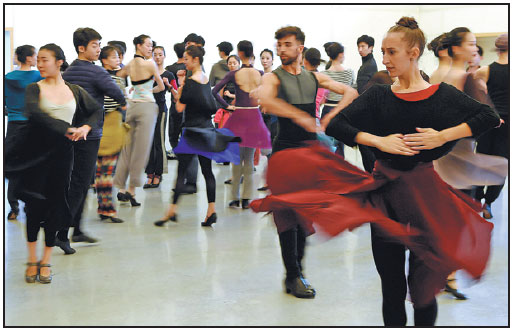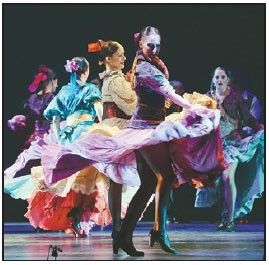With verve and vigor, Chinese fans get in step with flamenco
SHANGHAI - "In flamenco songs, there's a line that goes: 'I fell into a deep well without a rope', which is exactly how I feel now," says 42-year-old Tao Jiarong, a Shanghai-based white-collar worker who likes to indulge in the Spanish art of flamenco.
Dating back to 15th-century Spain, flamenco combines singing, dancing and guitar playing using varied rhythms and rich emotional expressions to create an art form that is quintessentially Spanish.
Flamenco is generally believed to be an artistic product of the Roma, the nomadic ethnic group also known as Gypsies, and their uprooted lives of grief, protest, hope and catharsis.
|
Dancers from the National Ballet of China practice flamenco with local dancers at the Theatre of Canal in Madrid in December. Guo Qiuda / Xinhua |
The art form has long been synonymous with the famous opera Carmen in China, but for Tao, "the deep well" is more like an inexhaustible treasure, to which she has now devoted almost all of her spare time.
"Currently, Shanghai has around 400 flamenco trainees a year, a very small number compared to the city's total population of more than 24 million," Tao says. But that number has been on the rise in recent years.
In a neighborhood near Zhongshan Park in Shanghai, Tao comes to the flamenco dance studio founded by her friend Shi Yiqi every week. More than 20 participants from nearby areas receive introductory training at the studio, where professional foreign dancers help them learn more about this comprehensive art form.
Mastering flamenco is quite a different prospect to learning ballroom dancing, for example, as the latter requires more cooperation and coordination between the dancers while the former exudes less tangible, but undeniably enchanting, cultural connotations.
As interest in flamenco spreads in China, an increasing number of flamenco studios and workshops have sprung up to cater for fans of the art. Initially only in major cities like Beijing, Shanghai, Hong Kong or Taipei, flamenco studios are now a common sight in cities such as Nanjing, Xi'an, Changsha, Chengdu and Chongqing, according to Shi.
"Flamenco itself is the synthesis of art," Tao says.
Tao still recalls the first time she saw flamenco at a performance by the Spanish national ballet in Shanghai in 2008. She was so struck by the grace and passion of the dancers floating across the stage in red dresses, that she immediately signed up for flamenco lessons.
|
The Ballet Teatro Espanol de Rafael Aguilar from Spain performs Carmen at the Guiyang Grand Theater in Guizhou province in December 2014. Qiao Qiming / For China Daily |
By the time Tao caught impromptu flamenco performances by Spanish dance masters at the Spanish pavilion of the 2010 Shanghai World Expo, she had a better understanding of it.
About three years ago, Tao decided to change from a flamenco dancer to a singer. While learning the songs, she soon realized that the exotic art was a kind of cultural treasure trove.
"Flamenco's philosophy is about fusion and acceptance. It's a kind of attitude. In the eyes of the audience, the dances and performances express extreme emotions, but ultimately, flamenco brings about self-reconciliation. I also feel reconciled with my heart and the world when I dance," says Tao.
Now, in addition to learning flamenco singing with Spanish performers via the internet, Tao also spends her holidays in Andalusia. There she is free to immerse herself in the range of singing styles found across the Spanish region, and also to take lessons and join in with performances.
"Shanghai now hosts several summer music festivals that feature flamenco music, giving people another channel to learn about the art form. More and more people are willing to travel to Spain to learn flamenco," Shi says, adding that her studio alone now has more than 80 trainee performers.
In flamenco, dancers in flower earrings flick and flutter across the stage like butterflies in trailing dresses - sweeping away any cultural differences in their path with a shared love for the arts.
Tao is happy that flamenco is gaining in popularity among Chinese people, but the country still lacks experienced musicians and singers. Tao and Shi plan to train more Chinese musicians and singers to help promote the art form in the future.
In 2018, they formed Shanghai's first homegrown flamenco band, which now plays regularly.
"Flamenco makes me feel alive. I have a hunch that I'll continue to love it in the future," Shi says.
Xinhua
(China Daily Global 08/08/2019 page15)




















